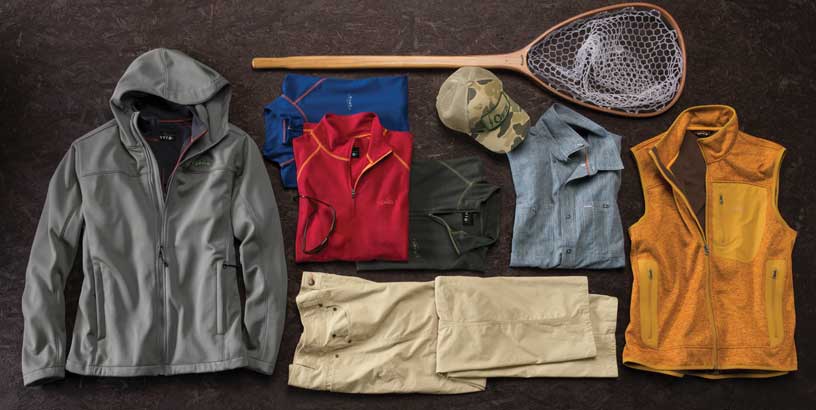Clothing
Colorado’s high altitude combined with more than 300 sunny days annually across most of the state, means one thing — variable temperatures. The high, dry climate allows nighttime temperatures to drop, while the sun and arid terrain spike temperatures midday. So when traveling to Colorado, dress in layers every day.
For a full day excursion on the water any time of the year, your upper body clothing should include, at minimum, three layers. The weight of those layers will vary depending on the season. But three layers will give you enough versatility to stay comfortable no matter what the day throws at you.
- A moisture-wicking base layer
- An insulating layer (fleece or down sweater) for cold weather, or a long-sleeved UV-protecting layer for warm weather
- A waterproof shell to protect from wind, rain, and snow.
Accessories
When it’s sunny almost every day, and since many rivers flow through open terrain, managing your exposure to the sun is very important. You’ll want to wear, or carry:
- A brimmed fishing hat: ball cap or full brim
- Polarized fishing sunglasses
- A UV buff to keep the sun off your neck and face
- Sunscreen and lip balm
For all-day comfort on the water, a pair of merino socks is recommended. They’ll help keep you warm in cold water, while wicking moisture away from the skin to keep you dry.
Fly-Fishing Gear
Which fly gear to bring all depends on the trip you’re planning. If you’re taking a “do-it-yourself” trip, you’ll need to pack all of your fly-fishing gear or rent it once you’re in the area. If you’re taking a guided trip, or staying at one of Colorado’s fly-fishing lodges, the guide will most likely provide you with much of the basic gear needed for the day.
Veteran Denver, Colorado fishing guide, Thomas Schneider explains, “One of the things that Sunrise Anglers prides themselves in is outfitting every client with everything and anything they need for their outing. I encourage clients to leave their equipment at home to try the latest greatest in Orvis gear. One crucial piece that I harp on is eye protection. A quality set of polarized eyeglasses or sunglasses not only serves as protection from sun and hooks, but we do a lot of sight fishing in tail-waters, freestone creeks, and float trips, and there is no substitute to seeing their quarry before the cast.”
Rod and Reel
If you’re only bringing one rod and reel combo, make it a fast-action 9 foot 4 weight fly rod with mid to large arbor reel, says Schneider. He suggests that if you’re not going with a guide, “The number one rod I would recommend is a 9 foot 4 weight. It can handle 95 percent of the fishing we do here in Colorado. Yes, it won't sling a double bunny rig, but it will handle everything else.”
Vest Or Pack
Fishing vests and packs are generally personal preference. Whatever portable storage system you use at home will probably work on most Colorado streams. If you’re hiring a guide for a float trip, they’ll often bring along bigger bags and boxes to supply a full day float. If you’re hiking some distance from your car, a larger pack would be preferred. But if you’re fishing one of Colorado’s Gold Medal streams near a road or town center, a small sling pack or vest will be more than enough.
Line, Leader, And Tippet
While you’ll most likely always be able to get away with fishing a weight forward floating line, it’s not a bad idea to bring a spare spool loaded with sinking line. For leaders, 3X to 4X should be sufficient for most conditions, with 4X to 7X tippet, in case the trout are sipping #20 or smaller midges and BWOs.
Flies
Before you go, check the hatch charts for the river(s) you’ll be visiting. Hatch charts will allow you to plan which flies to stock in your fly boxes. Once you’re near your destination, visit the local fly shops, talk to the staff, and buy something. They’ll often not only direct you towards the hot flies for that time of year, but may also give you directions to a few hotspots on the river.
Waders And Wading Boots
Colorado’s boulder-strewn rivers can be difficult to wade, especially the higher up you go in the mountains. Today’s rubber sole wading boots provide a sticky grip that, when paired with removable studs, match the grip of felt. Plus, rubber sole wading boots are less likely to carry invasive species between rivers.
Additional Accessories
- Camera: While your phone most likely takes great fish photos, a small point-and-shoot, action camera, or even a DSLR may be more handy to carry around. Then you can keep your phone packed away without burning through its battery, or risking getting it wet.
A water bottle and a sturdy cooler: Colorado’s climate is significantly drier than the Northwest or East. And when combined with the elevation, you quickly lose a lot of water from your body. If you’re used to fishing those areas it’s important to focus on your hydration while fishing in Colorado. Keep a sturdy cooler in your car or camp, so you always have cold water waiting for you.
)
)
)
)
)
)
)
)
)
)
)
